change wheel PONTIAC G6 2009 User Guide
[x] Cancel search | Manufacturer: PONTIAC, Model Year: 2009, Model line: G6, Model: PONTIAC G6 2009Pages: 410, PDF Size: 2.33 MB
Page 232 of 410
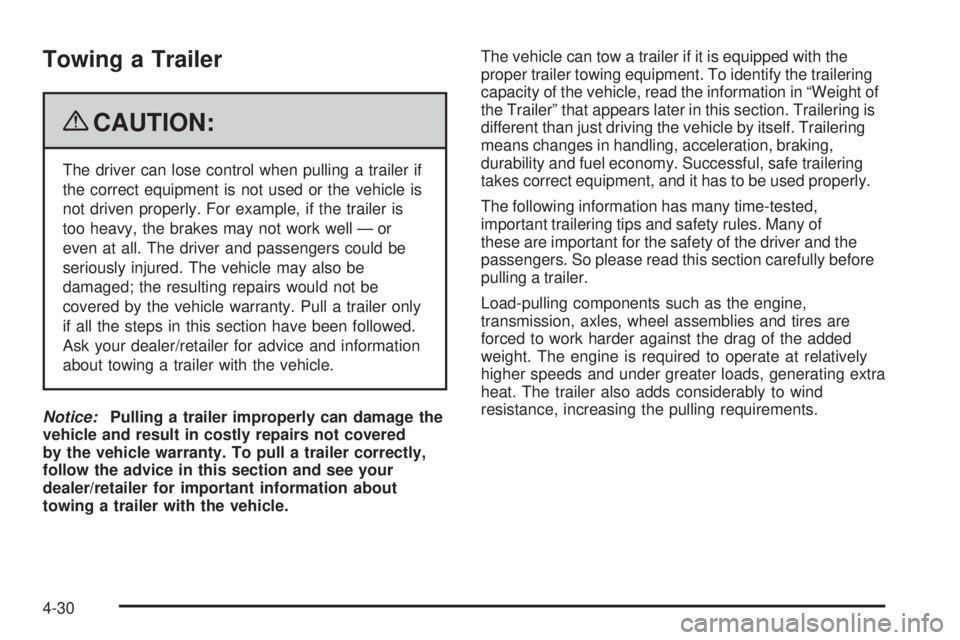
Towing a Trailer
{CAUTION:
The driver can lose control when pulling a trailer if
the correct equipment is not used or the vehicle is
not driven properly. For example, if the trailer is
too heavy, the brakes may not work well — or
even at all. The driver and passengers could be
seriously injured. The vehicle may also be
damaged; the resulting repairs would not be
covered by the vehicle warranty. Pull a trailer only
if all the steps in this section have been followed.
Ask your dealer/retailer for advice and information
about towing a trailer with the vehicle.
Notice:Pulling a trailer improperly can damage the
vehicle and result in costly repairs not covered
by the vehicle warranty. To pull a trailer correctly,
follow the advice in this section and see your
dealer/retailer for important information about
towing a trailer with the vehicle.The vehicle can tow a trailer if it is equipped with the
proper trailer towing equipment. To identify the trailering
capacity of the vehicle, read the information in “Weight of
the Trailer” that appears later in this section. Trailering is
different than just driving the vehicle by itself. Trailering
means changes in handling, acceleration, braking,
durability and fuel economy. Successful, safe trailering
takes correct equipment, and it has to be used properly.
The following information has many time-tested,
important trailering tips and safety rules. Many of
these are important for the safety of the driver and the
passengers. So please read this section carefully before
pulling a trailer.
Load-pulling components such as the engine,
transmission, axles, wheel assemblies and tires are
forced to work harder against the drag of the added
weight. The engine is required to operate at relatively
higher speeds and under greater loads, generating extra
heat. The trailer also adds considerably to wind
resistance, increasing the pulling requirements.
4-30
Page 236 of 410

Before starting, check all trailer hitch parts and
attachments, safety chains, electrical connectors, lamps,
tires and mirror adjustments. If the trailer has electric
brakes, start the vehicle and trailer moving and then
apply the trailer brake controller by hand to be sure the
brakes are working. This checks the electrical connection
at the same time.
During the trip, check occasionally to be sure that the
load is secure, and that the lamps and any trailer brakes
are still working.
Following Distance
Stay at least twice as far behind the vehicle ahead as
you would when driving the vehicle without a trailer. This
can help to avoid situations that require heavy braking
and sudden turns.
Passing
More passing distance is needed when towing a trailer.
Because the rig is longer, it is necessary to go much
farther beyond the passed vehicle before returning to
the lane.
Backing Up
Hold the bottom of the steering wheel with one hand.
Then, to move the trailer to the left, move that hand
to the left. To move the trailer to the right, move your
hand to the right. Always back up slowly and, if possible,
have someone guide you.
Making Turns
Notice:Making very sharp turns while trailering
could cause the trailer to come in contact with the
vehicle. The vehicle could be damaged. Avoid
making very sharp turns while trailering.
When turning with a trailer, make wider turns than
normal. Do this so the trailer will not strike soft shoulders,
curbs, road signs, trees or other objects. Avoid jerky or
sudden maneuvers. Signal well in advance.
Turn Signals When Towing a Trailer
The arrows on the instrument panel �ash whenever
signaling a turn or lane change. Properly hooked up, the
trailer lamps also �ash, telling other drivers the vehicle is
turning, changing lanes or stopping.
4-34
Page 298 of 410
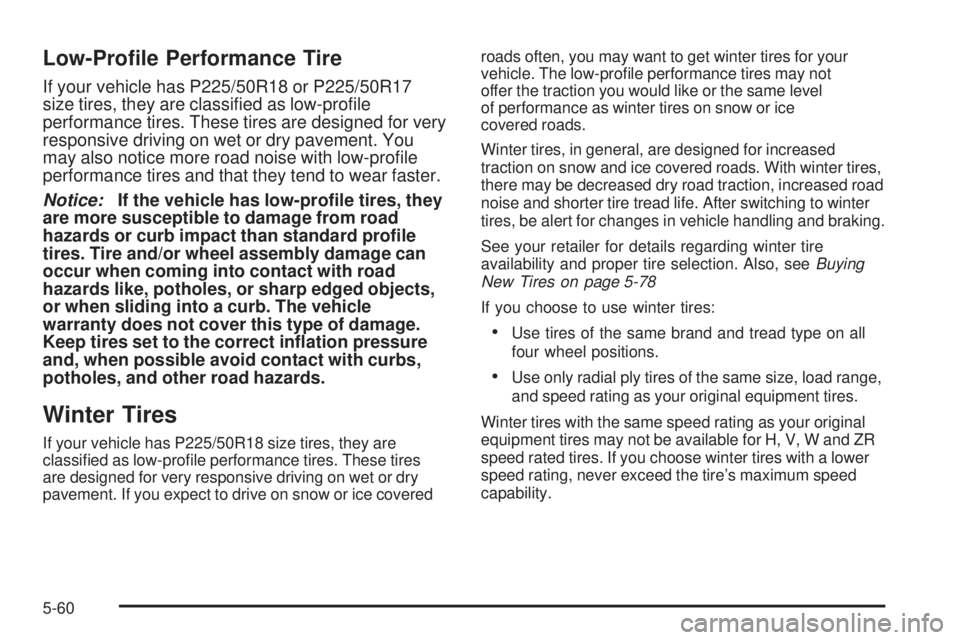
Low-Pro�le Performance Tire
If your vehicle has P225/50R18 or P225/50R17
size tires, they are classi�ed as low-pro�le
performance tires. These tires are designed for very
responsive driving on wet or dry pavement. You
may also notice more road noise with low-pro�le
performance tires and that they tend to wear faster.
Notice:If the vehicle has low-pro�le tires, they
are more susceptible to damage from road
hazards or curb impact than standard pro�le
tires. Tire and/or wheel assembly damage can
occur when coming into contact with road
hazards like, potholes, or sharp edged objects,
or when sliding into a curb. The vehicle
warranty does not cover this type of damage.
Keep tires set to the correct in�ation pressure
and, when possible avoid contact with curbs,
potholes, and other road hazards.
Winter Tires
If your vehicle has P225/50R18 size tires, they are
classi�ed as low-pro�le performance tires. These tires
are designed for very responsive driving on wet or dry
pavement. If you expect to drive on snow or ice coveredroads often, you may want to get winter tires for your
vehicle. The low-pro�le performance tires may not
offer the traction you would like or the same level
of performance as winter tires on snow or ice
covered roads.
Winter tires, in general, are designed for increased
traction on snow and ice covered roads. With winter tires,
there may be decreased dry road traction, increased road
noise and shorter tire tread life. After switching to winter
tires, be alert for changes in vehicle handling and braking.
See your retailer for details regarding winter tire
availability and proper tire selection. Also, seeBuying
New Tires on page 5-78
If you choose to use winter tires:
Use tires of the same brand and tread type on all
four wheel positions.
Use only radial ply tires of the same size, load range,
and speed rating as your original equipment tires.
Winter tires with the same speed rating as your original
equipment tires may not be available for H, V, W and ZR
speed rated tires. If you choose winter tires with a lower
speed rating, never exceed the tire’s maximum speed
capability.
5-60
Page 308 of 410

Your vehicle has also been equipped with a TPMS
malfunction indicator to indicate when the system is not
operating properly. The TPMS malfunction indicator is
combined with the low tire pressure telltale. When the
system detects a malfunction, the telltale will �ash
for approximately one minute and then remain
continuously illuminated. This sequence will continue
upon subsequent vehicle start-ups as long as the
malfunction exists.
When the malfunction indicator is illuminated, the
system may not be able to detect or signal low tire
pressure as intended. TPMS malfunctions may occur for
a variety of reasons, including the installation of
replacement or alternate tires or wheels on the vehicle
that prevent the TPMS from functioning properly.
Always check the TPMS malfunction telltale after
replacing one or more tires or wheels on your vehicle to
ensure that the replacement or alternate tires and
wheels allow the TPMS to continue to function properly.
SeeTire Pressure Monitor Operation on page 5-71
for additional information.Federal Communications Commission
(FCC) and Industry and Science Canada
The Tire Pressure Monitor System (TPMS) operates
on a radio frequency and complies with Part 15 of
the FCC Rules. Operation is subject to the following
two conditions:
1. This device may not cause harmful interference.
2. This device must accept any interference received,
including interference that may cause undesired
operation.
The TPMS operates on a radio frequency and complies
with RSS-210 of Industry and Science Canada.
Operation is subject to the following two conditions:
1. This device may not cause interference.
2. This device must accept any interference received,
including interference that may cause undesired
operation of the device.
Changes or modi�cations to this system by other than
an authorized service facility could void authorization to
use this equipment.
5-70
Page 315 of 410
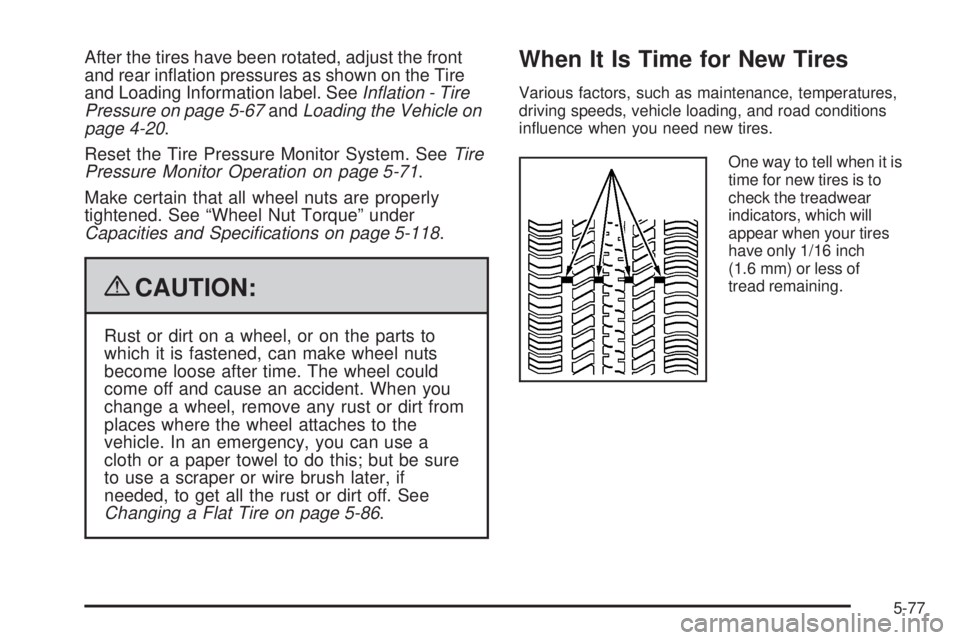
After the tires have been rotated, adjust the front
and rear in�ation pressures as shown on the Tire
and Loading Information label. SeeInflation - Tire
Pressure on page 5-67andLoading the Vehicle on
page 4-20.
Reset the Tire Pressure Monitor System. SeeTire
Pressure Monitor Operation on page 5-71.
Make certain that all wheel nuts are properly
tightened. See “Wheel Nut Torque” under
Capacities and Specifications on page 5-118.
{CAUTION:
Rust or dirt on a wheel, or on the parts to
which it is fastened, can make wheel nuts
become loose after time. The wheel could
come off and cause an accident. When you
change a wheel, remove any rust or dirt from
places where the wheel attaches to the
vehicle. In an emergency, you can use a
cloth or a paper towel to do this; but be sure
to use a scraper or wire brush later, if
needed, to get all the rust or dirt off. See
Changing a Flat Tire on page 5-86.
When It Is Time for New Tires
Various factors, such as maintenance, temperatures,
driving speeds, vehicle loading, and road conditions
in�uence when you need new tires.
One way to tell when it is
time for new tires is to
check the treadwear
indicators, which will
appear when your tires
have only 1/16 inch
(1.6 mm) or less of
tread remaining.
5-77
Page 323 of 410

If a Tire Goes Flat
It is unusual for a tire to blowout while you are driving,
especially if you maintain your vehicle’s tires properly.
If air goes out of a tire, it is much more likely to leak out
slowly. But if you should ever have a blowout, here
are a few tips about what to expect and what to do:
If a front tire fails, the �at tire creates a drag that pulls
the vehicle toward that side. Take your foot off the
accelerator pedal and grip the steering wheel �rmly.
Steer to maintain lane position, and then gently brake to
a stop well out of the traffic lane.
A rear blowout, particularly on a curve, acts much like a
skid and may require the same correction you would
use in a skid. In any rear blowout remove your foot from
the accelerator pedal. Get the vehicle under control
by steering the way you want the vehicle to go. It may
be very bumpy and noisy, but you can still steer. Gently
brake to a stop, well off the road if possible.{CAUTION:
Lifting a vehicle and getting under it to do
maintenance or repairs is dangerous without the
appropriate safety equipment and training. If a jack
is provided with the vehicle, it is designed only for
changing a �at tire. If it is used for anything else,
you or others could be badly injured or killed if the
vehicle slips off the jack. If a jack is provided with
the vehicle, only use it for changing a �at tire.
If a tire goes �at, the next part shows how to use the
jacking equipment to change a �at tire safely.
5-85
Page 324 of 410
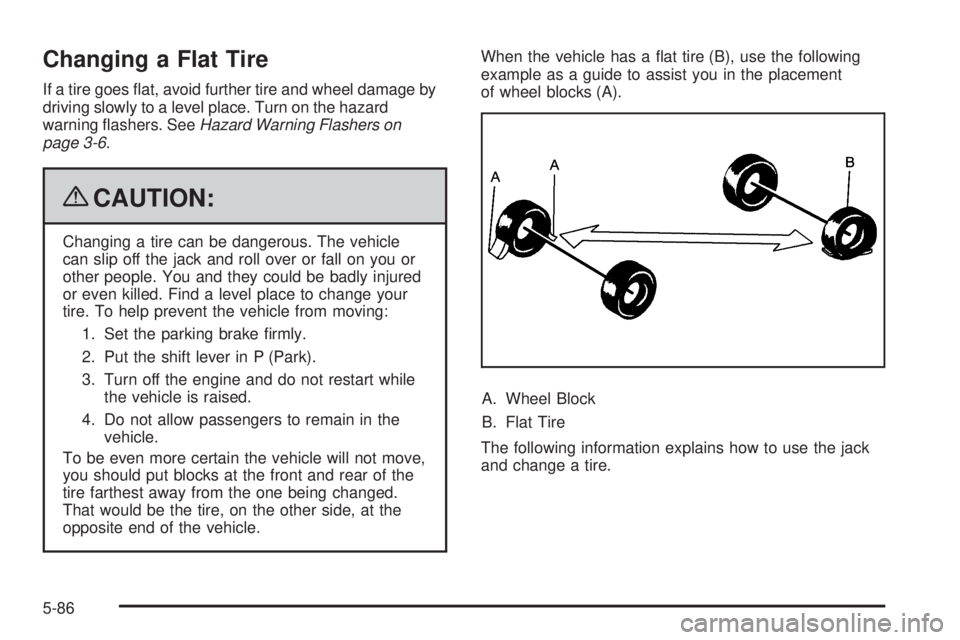
Changing a Flat Tire
If a tire goes �at, avoid further tire and wheel damage by
driving slowly to a level place. Turn on the hazard
warning �ashers. SeeHazard Warning Flashers on
page 3-6.
{CAUTION:
Changing a tire can be dangerous. The vehicle
can slip off the jack and roll over or fall on you or
other people. You and they could be badly injured
or even killed. Find a level place to change your
tire. To help prevent the vehicle from moving:
1. Set the parking brake �rmly.
2. Put the shift lever in P (Park).
3. Turn off the engine and do not restart while
the vehicle is raised.
4. Do not allow passengers to remain in the
vehicle.
To be even more certain the vehicle will not move,
you should put blocks at the front and rear of the
tire farthest away from the one being changed.
That would be the tire, on the other side, at the
opposite end of the vehicle.When the vehicle has a �at tire (B), use the following
example as a guide to assist you in the placement
of wheel blocks (A).
A. Wheel Block
B. Flat Tire
The following information explains how to use the jack
and change a tire.
5-86
Page 328 of 410

4. Use the wheel wrench to loosen all the wheel nuts.
Do not remove them yet.5. Position the lift head at the jack location nearest the
�at tire. Make sure all of the jack lift head is touching
the jacking �ange under the body. Do not place the
jack under a body panel. The lower body panel has
an arrow to aid in locating the jacking location.
6. Put the compact spare tire near the �at tire being
changed.
5-90
Page 408 of 410
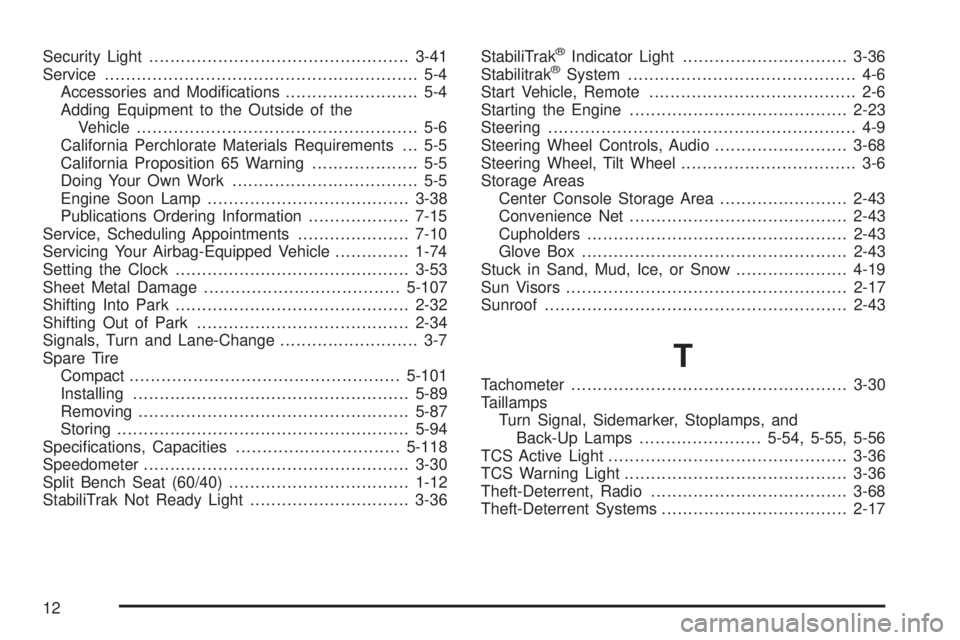
Security Light.................................................3-41
Service........................................................... 5-4
Accessories and Modi�cations......................... 5-4
Adding Equipment to the Outside of the
Vehicle..................................................... 5-6
California Perchlorate Materials Requirements . . . 5-5
California Proposition 65 Warning.................... 5-5
Doing Your Own Work................................... 5-5
Engine Soon Lamp......................................3-38
Publications Ordering Information...................7-15
Service, Scheduling Appointments.....................7-10
Servicing Your Airbag-Equipped Vehicle..............1-74
Setting the Clock............................................3-53
Sheet Metal Damage.....................................5-107
Shifting Into Park............................................2-32
Shifting Out of Park........................................2-34
Signals, Turn and Lane-Change.......................... 3-7
Spare Tire
Compact...................................................5-101
Installing....................................................5-89
Removing...................................................5-87
Storing.......................................................5-94
Speci�cations, Capacities...............................5-118
Speedometer..................................................3-30
Split Bench Seat (60/40)..................................1-12
StabiliTrak Not Ready Light..............................3-36StabiliTrak®Indicator Light...............................3-36
Stabilitrak®System........................................... 4-6
Start Vehicle, Remote....................................... 2-6
Starting the Engine.........................................2-23
Steering.......................................................... 4-9
Steering Wheel Controls, Audio.........................3-68
Steering Wheel, Tilt Wheel................................. 3-6
Storage Areas
Center Console Storage Area........................2-43
Convenience Net.........................................2-43
Cupholders.................................................2-43
Glove Box..................................................2-43
Stuck in Sand, Mud, Ice, or Snow.....................4-19
Sun Visors.....................................................2-17
Sunroof.........................................................2-43
T
Tachometer....................................................3-30
Taillamps
Turn Signal, Sidemarker, Stoplamps, and
Back-Up Lamps.......................5-54, 5-55, 5-56
TCS Active Light.............................................3-36
TCS Warning Light..........................................3-36
Theft-Deterrent, Radio.....................................3-68
Theft-Deterrent Systems...................................2-17
12
Page 409 of 410

Theft-Deterrent Systems (cont.)
Content Theft-Deterrent................................2-17
PASS-Key
®III+ Electronic Immobilizer............2-19
PASS-Key®III+ Electronic Immobilizer
Operation................................................2-19
Tilt Wheel........................................................ 3-6
Time, Setting..................................................3-53
Tire
Pressure Light.............................................3-37
Tires.............................................................5-59
Aluminum Wheels, Cleaning........................5-107
Buying New Tires........................................5-78
Chains.......................................................5-84
Changing a Flat Tire....................................5-86
Cleaning...................................................5-107
Compact Spare Tire...................................5-101
Different Size..............................................5-80
High-Speed Operation..................................5-68
If a Tire Goes Flat.......................................5-85
In�ation - Tire Pressure................................5-67
Inspection and Rotation................................5-76
Installing the Spare Tire................................5-89
Pressure Monitor Operation...........................5-71
Pressure Monitor System..............................5-69
Removing the Flat Tire.................................5-89
Removing the Spare Tire and Tools...............5-87Tires (cont.)
Storing a Flat or Spare Tire and Tools............5-94
Tire Sidewall Labeling..................................5-61
Tire Terminology and De�nitions....................5-64
Uniform Tire Quality Grading.........................5-80
Wheel Alignment and Tire Balance.................5-82
Wheel Replacement.....................................5-83
When It Is Time for New Tires......................5-77
Winter Tires................................................5-60
Towing
Recreational Vehicle.....................................4-26
Towing a Trailer..........................................4-30
Your Vehicle...............................................4-26
Traction
Control System Active Light
..........................3-36
Control System (TCS).................................... 4-7
Control System Warning Light.......................3-36
Stabilitrak
®System........................................ 4-6
Transmission
Fluid, Automatic...........................................5-29
Transmission Operation, Automatic....................2-26
Trip Odometer................................................3-30
Trunk............................................................2-12
Trunk Lamps..................................................3-17
Turn and Lane-Change Signals.......................... 3-7
Turn Signal/Multifunction Lever........................... 3-7
13